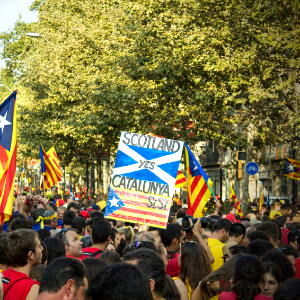This blog is part of the COMPAS Coronavirus and Mobility Forum.
In order to understand the multifaceted effects of mobility restriction during COVID-19, it is important to examine the broader political situation of the independence movements in Catalonia and Scotland. We argue that the current pandemic crisis has shed new light on several trends for both independence movements.
While the Scottish National Party (SNP) enjoyed the devolved government structure and aimed to distinguish its health services from that in England, and to convert its success in dealing with the pandemic to wider support for an independence, and calling for a second referendum for independence; the Catalan independence movement had to react to centralised strategies of the Spanish government, and the movement suffered from the lack of leadership which worsened the problem during the pandemic. Mobility restriction seems to have had opposite effects on the two movements.
Have policies of (im)mobility strengthened or discouraged feelings of independence in Catalonia?
Although the Catalan independence movement gained worldwide recognition mainly with the 2017 referendum, this movement has a long history. It is suggested that the Catalan political nationalism already emerged in the 19 Century. The movement experienced a severe crackdown from Franco’s military regime (1936-1975). For some, the referendum held in 2017 raised memories of this trauma which, in turn, increased the fervour for independence.
Memories of the dictatorship may have arisen with the current pandemic, but in symbolic ways. The monarchy- seen by some Catalans as inherited from the Francoist regime- has been observed supporting the politics of immobility during the lockdown and claiming the need to remain united as a country during the crisis. Similarly, the Central Government deployed the army to disinfect and to patrol the streets to ensure immobility through confinement. Although this took place throughout the country, a minority of Catalans might be reminded of the dictatorship’s repression.
Tensions are generally perceived between the ‘Generalitat de Catalunya’ (Government of Catalonia), and the Spanish State. These were aggravated in the state of emergency, with the aim of responding to the pandemic, when the central State made use of its exceptional capacity to adopt policies of (im)mobility and applied it to all Autonomous Communities. Also, when Catalonia became the second epicentre of positive cases in Spain, the Catalan government asked for the closure of Catalonia’s borders. However, their request was refused by the central government. The ‘Generalitat of Catalunya’ subsequently argued that an independent Catalonia would have acted earlier and closed its borders, resulting in less fatalities.
Yet, these tensions exist also within the separatist movement. Elements creating tensions include the lack of leadership and internal divisions. Even before the pandemic, there was a crisis in the independentist movement as there was no clear leadership. As a result of the 2017 referendum, Carles Puigdemont, former President of Catalonia, is in self-exile and Oriol Junqueras, former Vice President, in prison. This uncertainty within the separatist movement was aggravated with the COVID-19-induced uncertainty. The difficulty of confinement amounted to the hardship of people within the movement already on trial, receiving fines, in exile or in prison as a result of the 2017 referendum. The feeling of independence has been shaped by (im) mobility policies, but it is hard to tell what form it has taken.
Measures against pandemic to raise the independence movement in Scotland
Polls suggest that more Scots prefer an independent country during the pandemic than before. COVID-19 is not the only reason for the increasing support to Scottish independence. The Brexit referendum and Johnson’s Tory government had strengthened the independence sentiment before the pandemic. However, following the COVID-19 pandemic, Scottish First Minister Sturgeon’s leadership approval increased in opposition to Johnson, and she could demonstrate her ability to manage pandemic better than the rest of the UK. This inspired Scots to imagine an independent and possibly an EU-member Scotland would live in better conditions than the current stage.
Such success is partly related to the Scottish government’s ability to manage the mobility of the population. Although Scottish government has applied more draconian measures for the people in Scotland about visiting their homes or going out to pubs and restaurants, they also highlighted the English-Scottish border and imposed restrictions for “English residents” to visit Scotland. Such control over the border and additional measures on mobility within Scotland, objectively, eliminated and sidelined the power of Johnson’s government which fell into a category of “the English government” instead of a “UK government”.
Conclusion
The Scottish government effectively used the tools to control and manage immobility within Scotland and in relation to England. By doing so it differentiated itself from Westminster to promote its independence cause. Success in dealing with the pandemic in comparison to England became evidence for the necessity of an independent country.
On the other hand, in the Catalan case, the Spanish central government used the pandemic as an opportunity to further centralization. This challenge amounted to the hardship derived from confinement and the internal contradictions within the independence movement.
Lore M. Purroy Sánchez is currently undertaking an MPhil in Development Studies at the University of Oxford.
Dr Emre Eren Korkmaz is a political scientist at the University Oxford and teaches on the MSc in Migration Studies.
